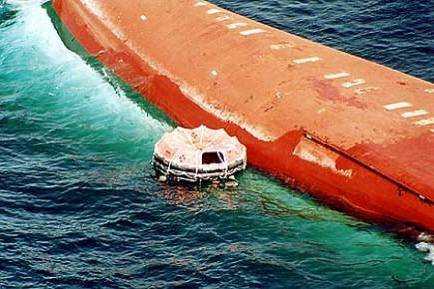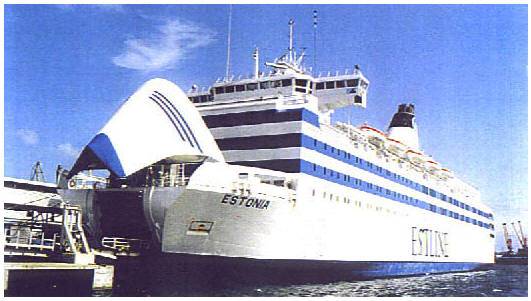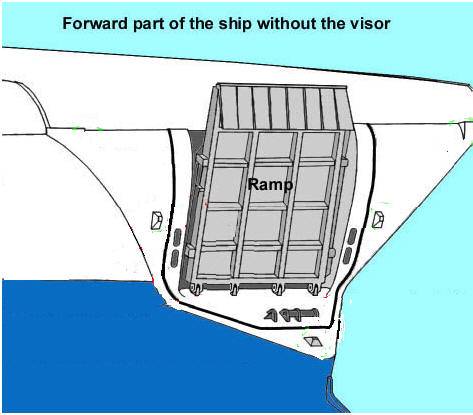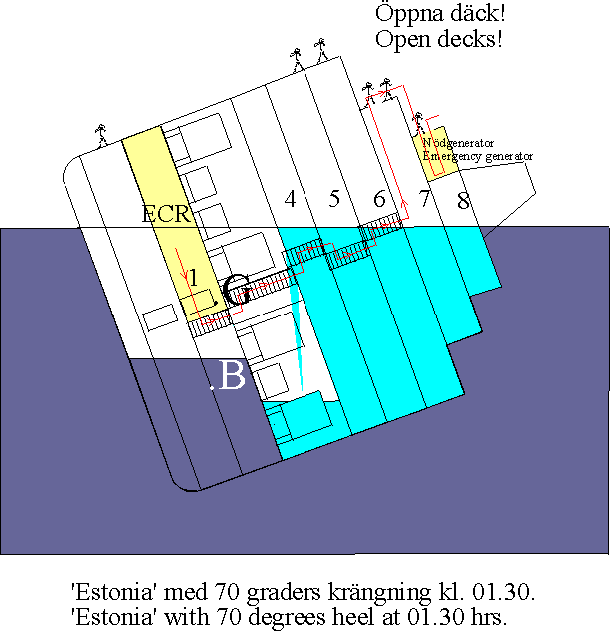The last message from the stricken ferry - which was carrying mainly Swedish passengers from Tallinn to Stockholm - was received by the Finnish Coastguard at 0124 BST.
Survivors reported the boat sank within five minutes.
|
Ferry Sinks; More than 850 Feared Dead
6 ft seas
Chicago, IL, (ENN) September 29, 1994 -- With hope fading with each passing
hour, families all over Sweden, Estonia, and Finland are anxiously awaiting the
fate of relatives that were known to be traveling on the ES Estonia.
The ferry, traveling between Estonia and
Sweden, inexplicably sank Tuesday at 1:24a.m.(local time). According to the
Estonia Foreign Ministry, 1,049 people were onboard the ship as it capsized in
6-foot waves. Finnish rescue services have reported that 844 people are
still missing, and that about 140 have been saved from the frigid waters of the
Baltic Sea. The bodies of 42 people are said to have been recovered by rescue
forces. The ship went down, reportedly within 40 minutes, in an area
approximately 25 miles from the Southwest coast of Finland.
In what is being described by Swedish authorities as
"the greatest catastrophe for Sweden in
modern times", the sinking of the Estonia has roused an intensive
investigation into the disaster. Speculation regarding the cause of the tragic
incident has centered on the possibility of "faulty" seals on a large ramp that
is used to on and off-load cars and people from the ship. A crewman and another
eyewitness have both been quoted by various media sources as saying that water
was seen coming in through the bow door of the ship. The crewman was quoted by
the Cable News Network (CNN) as saying that he was standing in water "up to his
knees" at the time the ship capsized.
Representatives of the Estline Company, which operated the Estonia, were quoted
by local media services as saying that the vessel sank after it's engines
shut-down and it was swept by a "60 foot wave [20 meters]".
Weather experts say that the allegation
about a sixty foot wave was extremely unlikely, due to the fact that several
other ships were in the area and they reported "6 foot [2 meter] waves in the
area" with winds at 15mph. Ostensibly, after the wave struck, the ships
cargo area filled with water and began to list. Shortly thereafter, according to
survivors, the ship capsized.
According to two Swedish safety inspectors, the seals on the ship's cargo doors
"didn't look good" when inspected shortly before the calamity. Ake Sjoblom, one
of the inspectors, was quoted by a Swedish radio station as saying that the
Estonia's crew was notified of the deficiencies, but that the visit that their
visit was "only for training" and that it wasn't "a proper inspection". He also
said that the seals 'didn't look bad enough to hold the boat back."
Finnish authorities said that the incident occurred in Finnish waters and that
it is their responsibility to conduct a complete and thorough investigation of
the accident. They said that they would not comment on the actual cause of the
deadly tragedy until the completion of the official inquiry. The spokesperson
refused to speculate regarding any details of the disaster.
Rescuers have been frantically searching the area of the shipwreck for more than
48 hours. They say that they have been hampered by high winds and heavy seas,
almost since they started the search. Several other ships, in the area, have
reported plucking victims from the icy waters and turning them over to Finnish
Coast Guard helicopters for transport to local hospitals. A massive rescue
effort has reportedly been mounted by Sweden, Finland, and Estonia, with
helicopters and patrol boats working 24 hours a day in an attempt to save
victims in the 50 degree water.
Rescuers and doctors say, however, that they fear that the time has elapsed that
would have allowed them to successfully resuscitate those thrown into the cold
water. They say that the stricken will have died of hypothermia and exposure by
the time of this report. A Coast Guard official said that the human body loses
heat quickly when immersed in cold water, and that they have already recovered
the bodies of "dozens" of victims who have succumbed to the cold. A Finnish
Helicopter rescue pilot reported flying more than 10 hours and not finding
anyone alive; his crew did recover the bodies of twenty (20) of the Estonia's
deceased.
Doctors treating the few survivors of the Estonia disaster say that it is a
"miracle" that anyone survived the incident and subsequent immersion in the
chilly water. Those that did survive may have done so by huddling together, in
life rafts that were thrown from the ship, as it was going down. A trauma
physician from Turku University Hospital said that all of the victims that were
brought to his facility were suffering from hypothermia, but that several of
them are doing 'extremely well", considering the circumstances. According to one
doctor, several of the patients may be released from the hospital soon, with few
medical complications. A hospital psychologist said, however, that virtually all
of the survivors will suffer from some form of emotional distress surrounding
the incident.
Survivors of mass disasters are frequently known to suffer from effects similar
to those experienced by soldiers in combat, resulting in what is commonly called
a "Post Traumatic Stress Syndrome". Some will undoubtedly require counseling and
emotional support following their ordeal in the Baltic's icy waters. Others will
even feel guilty that they couldn't help the dead, or do anything meaningful to
affect the outcome of the calamity. All in all; everyone connected with the
tragedy at sea will suffer some detrimental effect caused by the sinking of the
Estonia. Now, as questions are being asked about the cause of the disaster,
families, friends, rescuers and victims will begin the grieving process.
Bomb
'Officials discount "Estonia"
bomb
claim'. (Claims that the new
video footage of the wreck of the "Estonia"
may prove that a
bomb explosion sank the ill-fated
vessel have been discounted by
Finnish officials who investigated the tragedy) - LLOYD'S LIST, 8 September
2000, p 3
Estonia" blast not ruled out'. (Gregg Bemis, the leader of a team of divers working on the wreck of the ferry "Estonia" has not ruled out the possibility that explosive damage sank the ferry in 1994) - FAIRPLAY, 14 September 2000, p 15
'Divers spur call for new "Estonia" probe'. (Pressure is growing on the Finnish and Swedish governments to re-open the investigation into the sinking of the "Estonia" following a controversial diving expedition to the wreck) - TRADEWINDS, 15 September 2000, p 28
'Through a hole darkly'. (Muddy waters still obscure "Estonia"truths) - FAIRPLAY, 28 September 2000, pp 3-4
'Leaders of the Estonia diving team face arrest'. (A 72-year old American and a German television producer face possible imprisonment in Sweden for diving at the wreck of the "Estonia" ferry which sank in 1994 with the loss of 852 lives) - LLOYD'S LIST, 11 October 2000, p 20
'Diver says explosion sunk "Estonia"'.
(The scientific examination of metal fragments recovered from the "Estonia"
wreck show that an explosion occurred on board the vessel, claims US businessman
Greg Bemis, who led the
controversial diving expedition) - LLOYD'S LIST, 7 November 2000, p 3
 |
|
According to the German Meyer shipyard the Estonia was victim of an attack by explosives. Sabotage, in combination with bad maintenance, sank the ship, the shipyard suggests.152
Several parties are requesting a new investigation to finally clarify all outstanding questions. In January the international and the Nordic transport workers federations demanded a new Estonia investigation. Last spring the press secretary of the minister assured, according to the press, that the government would make a decision before summer. It was not the case.
The visor fell off after the list occurred. The ramp protecting the superstructure was never open. A big damage in the starboard collision bulkhead is not reported or explained by the Commission.
, p 6
Neither the leading hull underwriter nor the P&I club Skuld has ever taken an active interest into the real cause of the accident 3.20. They paid all claims long before the investigation was terminated when no evidence was available to prove the alleged cause of accident. That the manipulated, official investigation is part of a clever insurance fraud is today a valid consideration.*
The silence of the insurance underwriters during the investigation supports the suggestion that the investigation was manipulated as part of an insurance fraud.
 |
1994"Estonia" September 28 - Estonian Steamship Line's "Estonia," while enroute to Stockholm, hits rough seas and sinks in the Baltic Sea. Over 900 lives were lost; most of the passengers never made it out of their cabins. |







